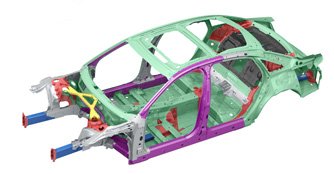Unique mix of materials used for the new Audi A8
07 Apr 2017|2,294 views
Audi is writing a new chapter in its lightweight design success story. For the next generation of the Audi A8, an intelligent mix of four materials is being used for the first time in the weight-bearing body structure - more materials than in any of the brand's previous production models.
The luxury saloon is thus once again rightfully claiming its role as an innovation driver in automotive lightweight design: Its low weight and impressive rigidity offer greater performance, efficiency and safety. With a mix of aluminium, steel, magnesium and Carbon Fibre Reinforced Polymer (CFRP) they are establishing a new stage in multi-material construction in the Audi Space Frame (ASF) for the next generation of the Audi A8 - in keeping with the principle 'the right material in the right place and in the right amount.'
In terms of its overall dimensions, an ultra-high-strength, torsionally rigid rear panel made of CFRP is the largest component in the occupant cell of the new Audi A8, and it contributes 33 percent to the torsional rigidity of the total vehicle. To optimally absorb longitudinal and transverse loads as well as shearing force, between six and 19 fibre layers are placed one on top of the other, ensuring a load-optimised layout.
A high-strength combination of hot-formed steel components make up the occupant cell, which comprises the lower section of the front bulkhead, the side sills, the B-pillars and the front section of the roof line. Some of these sheet metal blanks are produced in varying thicknesses using tailoring technologies - meaning they are customised - and others also undergo partial heat treatment. That reduces weight and increases the strength, especially in areas of the vehicle that are particularly critical for safety.
The aluminium components make up 58 percent of the new Audi A8 body, the largest share in the mix of materials. Cast nodes, extruded profiles and sheets are the elements characteristic of the ASF design. And here too the competition of materials has been driving progress.
Rounding out the intelligent mix of materials is the magnesium strut brace. A comparison with the predecessor model shows that it contributes 28 percent of weight savings. Aluminium bolts secure the connection to the strut tower domes, making them a guarantor of the body's high torsional rigidity.
Audi is writing a new chapter in its lightweight design success story. For the next generation of the Audi A8, an intelligent mix of four materials is being used for the first time in the weight-bearing body structure - more materials than in any of the brand's previous production models.
The luxury saloon is thus once again rightfully claiming its role as an innovation driver in automotive lightweight design: Its low weight and impressive rigidity offer greater performance, efficiency and safety. With a mix of aluminium, steel, magnesium and Carbon Fibre Reinforced Polymer (CFRP) they are establishing a new stage in multi-material construction in the Audi Space Frame (ASF) for the next generation of the Audi A8 - in keeping with the principle 'the right material in the right place and in the right amount.'
In terms of its overall dimensions, an ultra-high-strength, torsionally rigid rear panel made of CFRP is the largest component in the occupant cell of the new Audi A8, and it contributes 33 percent to the torsional rigidity of the total vehicle. To optimally absorb longitudinal and transverse loads as well as shearing force, between six and 19 fibre layers are placed one on top of the other, ensuring a load-optimised layout.
A high-strength combination of hot-formed steel components make up the occupant cell, which comprises the lower section of the front bulkhead, the side sills, the B-pillars and the front section of the roof line. Some of these sheet metal blanks are produced in varying thicknesses using tailoring technologies - meaning they are customised - and others also undergo partial heat treatment. That reduces weight and increases the strength, especially in areas of the vehicle that are particularly critical for safety.
The aluminium components make up 58 percent of the new Audi A8 body, the largest share in the mix of materials. Cast nodes, extruded profiles and sheets are the elements characteristic of the ASF design. And here too the competition of materials has been driving progress.
Rounding out the intelligent mix of materials is the magnesium strut brace. A comparison with the predecessor model shows that it contributes 28 percent of weight savings. Aluminium bolts secure the connection to the strut tower domes, making them a guarantor of the body's high torsional rigidity.
Latest COE Prices
July 2025 | 1st BIDDING
NEXT TENDER: 23 Jul 2025
CAT A$101,102
CAT B$119,600
CAT C$66,689
CAT E$118,500
View Full Results Thank You For Your Subscription.
























